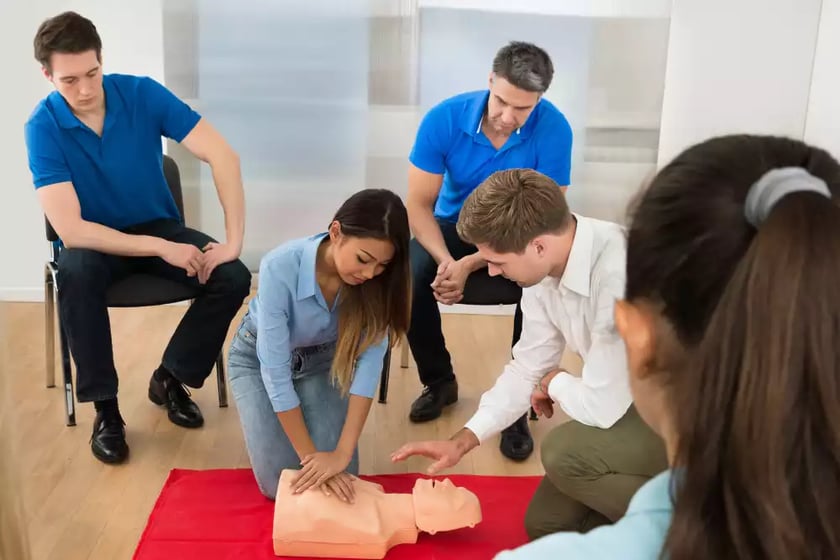By
Rob Eckwall
on
Mar
25,
2025
4 min read
2 Comments

CPR—short for Cardiopulmonary Resuscitation—is a lifesaving emergency procedure used to assist victims of cardiac arrest. By maintaining circulation through chest compressions and rescue breaths, CPR increases the chances of survival.
Since cardiac emergencies can happen anywhere—including the workplace—CPR training for business environments is a crucial part of a comprehensive safety program.
At Axcet HR Solutions, our Safety and Health Consultants are certified through the American Red Cross, ensuring businesses receive expert guidance when implementing workplace CPR training as part of their overall safety program.
RELATED: Workplace Safety Laws Every Business Must Follow >>
Each year, approximately 10,000 cardiac arrests occur in U.S. workplaces. Immediate CPR can significantly improve survival rates, sometimes tripling a victim’s chances. Because it requires no special medical equipment and can be performed on any firm surface, workplace CPR training is an accessible, cost-effective way to protect employees, customers and visitors.
The American Red Cross (ARC) outlines key CPR steps that employees should be familiar with:
1. Check for Responsiveness and Call for Help
2. Perform Chest Compressions
3. Deliver Rescue Breaths (If Trained and Comfortable)
4. Continue CPR Until Help Arrives
Automated External Defibrillators (AEDs) are critical in treating sudden cardiac arrest, significantly increasing survival rates when used promptly. The American Red Cross emphasizes that AEDs should be used as soon as possible when available.
According to the American Heart Association:
Having an AED in the workplace increases the chances of survival, as first responders may take precious minutes to arrive. To enhance workplace safety, businesses should consider not only CPR training but also equipping their workplaces with AEDs and training employees on their proper use.
Many organizations have implemented AED programs, ensuring quick access in emergencies.
RELATED: Workplace First Aid Kit Essentials - What Every Employer Should Include >>
CPR training for employees is an invaluable investment in workplace safety. Considering the high number of workplace cardiac arrests each year, ensuring employees are prepared can mean the difference between life and death.
Some of the top reasons businesses should implement workplace CPR training include:
Immediate CPR dramatically improves survival chances in a cardiac event.
While not always required, CPR training aligns with OSHA’s commitment to workplace safety and emergency preparedness.
CPR training is relatively quick and easy to learn but provides lifelong skills that could save lives.
Employees who feel prepared for emergencies contribute to a safer, more confident work environment.
There are multiple options for CPR training tailored to workplace settings:
The American Red Cross offers OSHA-compliant training programs that bring instructors and equipment directly to your business.
One of your employees can become an authorized trainer through organizations like the Red Cross, allowing for in-house CPR education.
Employees can attend in-person CPR training at AHA-certified facilities.
Many programs offer blended learning, combining online coursework with in-person skills assessments to ensure employees gain hands-on experience.
Most CPR certifications last about two years, but ongoing education is encouraged. Since CPR knowledge declines without practice, businesses should consider refresher courses and provide reminders through workplace materials like posters or mobile apps.
RELATED: How a Workplace Risk Assessment Improves Safety and OSHA Compliance >>
A workplace safety program that includes CPR training can help turn a potential tragedy into a success story. Axcet HR Solutions not only assists businesses in developing comprehensive health and safety programs but also offers CPR training as part of our comprehensive PEO services for small and mid-sized businesses.
This ensures employees are equipped with the knowledge and training they need to handle workplace emergencies effectively. Investing in CPR training for business settings is a proactive step toward creating a safer workplace for everyone.
Ready to enhance your workplace safety program? Contact Axcet HR Solutions today to learn more about our full suite of HR services, including CPR training offerings.
Let us know what you think...